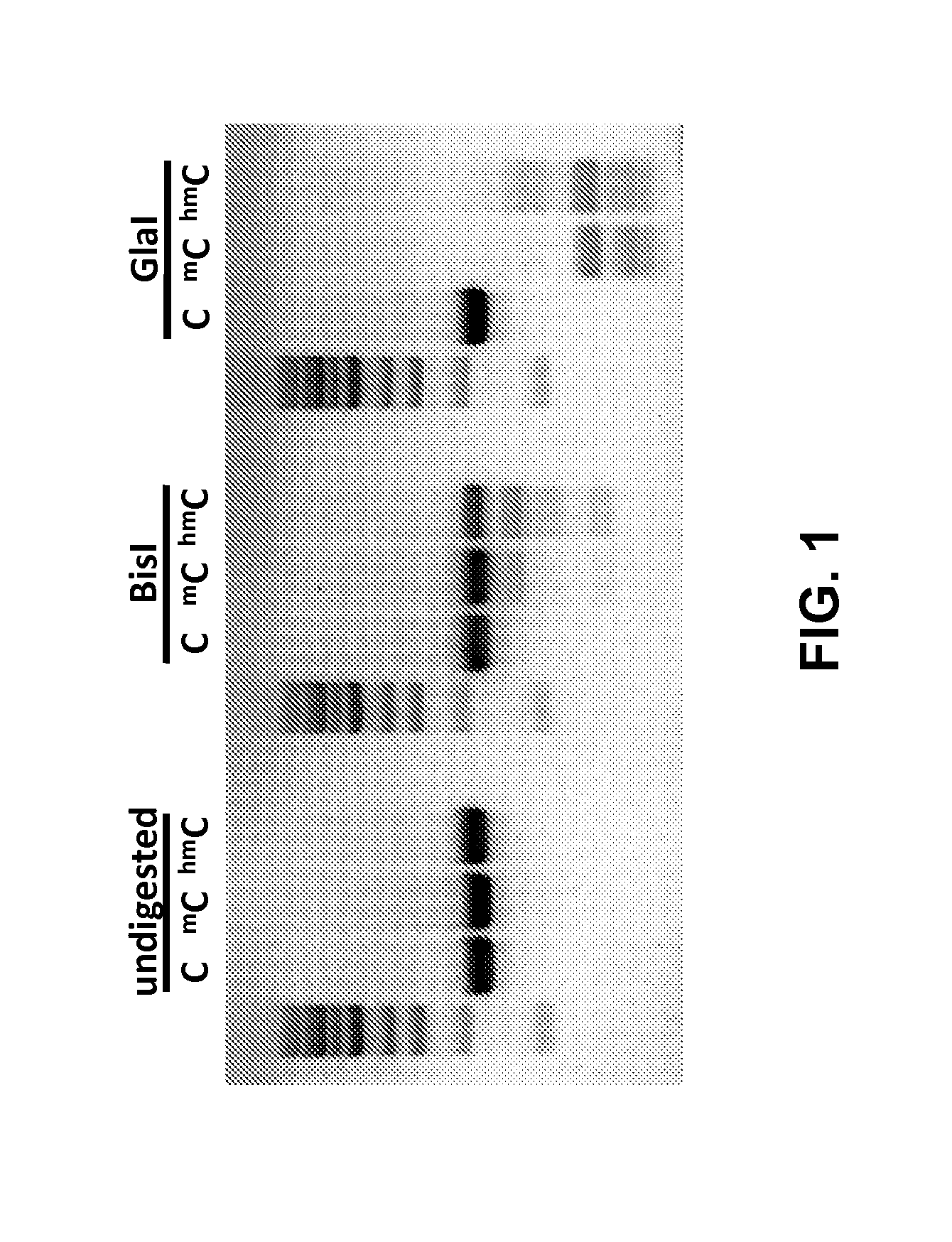Detection of DNA hydroxymethylation
- Summary
- Abstract
- Description
- Claims
- Application Information
AI Technical Summary
Benefits of technology
Problems solved by technology
Method used
Image
Examples
example 1
Methylation Dependent Endonuclease Enzymes Cleave Both 5′mC and 5′hmC
[0078]In order to determine if methylation dependent DNA endonucleases could cut at positions comprising both a 5′mC and 5′hmC PCR products were amplified using primers: 5′ (AGA ATT GGT TAA TTG GTT GTA A; SEQ ID NO: 7) and 3′ (ATA TTT GAA TGT ATT TAG AAA AAT AAA; SEQ ID NO: 8). Resulting PCR products have the same primary sequence (SEQ ID NO: 9) and differing only in the modification status of cytosines were digested with the BisI and GlaI endonucleases and analyzed by agarose gel electrophoresis (FIG. 1). Results of the experiment show that, although the BisI cleavage was not complete both enzymes cleaved DNA molecules comprising 5′mC and 5′hmC positions essentially equally.
example 2
Glucosylation of 5′hmC Prevents Cleavage By Methylation Dependent Endonuclease Enzymes
[0079]In order to determine if the addition of a larger covalently linked moiety to 5′hmC could inhibit cleavage by a methylation dependent endonucleases, PCR products having the same primary sequence and differing only in the modification status of cytosines were digested with MspI and analyzed by agarose gel electrophoresis (FIG. 2A). Digests were carried out for 3 hours at recommended enzyme reaction conditions either on untreated DNA sample of on samples treated with a β-glucosyltransferase from T4 bacteriophage. The results show that addition of the glucose to 5′hmC effectively inhibited MspI cleavage. Furthermore, results from FIG. 2A demonstrate that glucosylation was specific to 5′hmC and was very efficient, in that essentially all of the DNA was protected from cleavage.
example 3
Hemi-Glu-5′hmC Prevents Cleavage By Methylation Dependent Endonuclease Enzymes
[0080]In order to determine whether glucosylation of 5′hmC both strands of DNA was required to inhibit cleavage, a DNA template with hemi-Glu-5′hmC (TAAAAGCTAACCGCATCTTTACCGACAAGGCATCCGGCAGTTCAACAGATCGGG AAGGGCTGGATTTGCTGAGGATGAAGGTGGA; SEQ ID NO: 10, underlined “C” was modified to Glu-5′hmC) was digested with MspI and analyzed by agarose gel electrophoresis. The results shown in FIG. 3 demonstrate that hemi-Glu-5′hmC effectively blocks MspI digestion.
PUM
| Property | Measurement | Unit |
|---|---|---|
| Volume | aaaaa | aaaaa |
| Volume | aaaaa | aaaaa |
| Volume | aaaaa | aaaaa |
Abstract
Description
Claims
Application Information
 Login to View More
Login to View More - R&D
- Intellectual Property
- Life Sciences
- Materials
- Tech Scout
- Unparalleled Data Quality
- Higher Quality Content
- 60% Fewer Hallucinations
Browse by: Latest US Patents, China's latest patents, Technical Efficacy Thesaurus, Application Domain, Technology Topic, Popular Technical Reports.
© 2025 PatSnap. All rights reserved.Legal|Privacy policy|Modern Slavery Act Transparency Statement|Sitemap|About US| Contact US: help@patsnap.com



